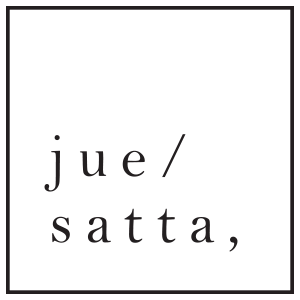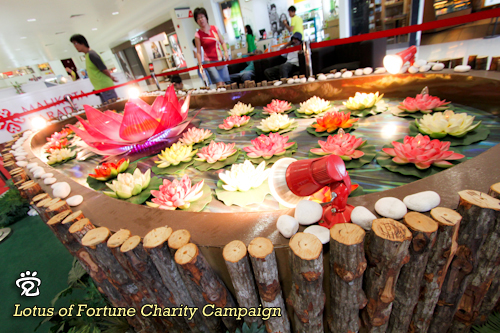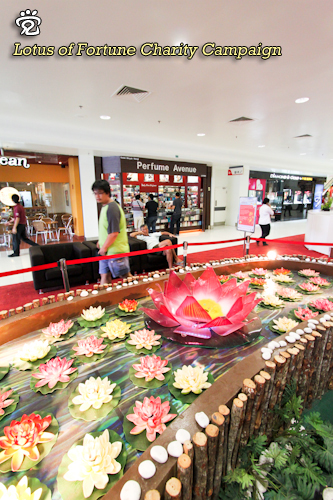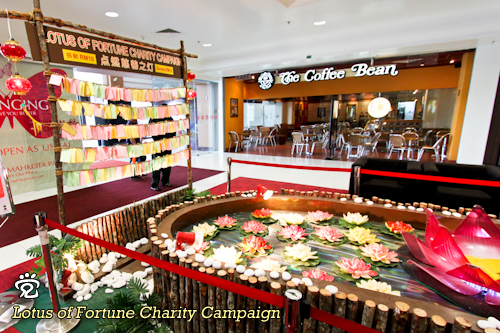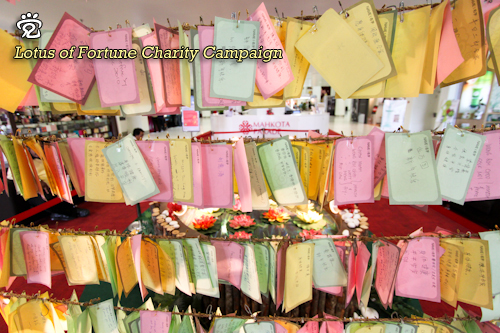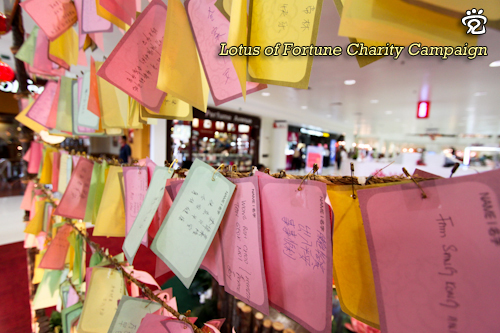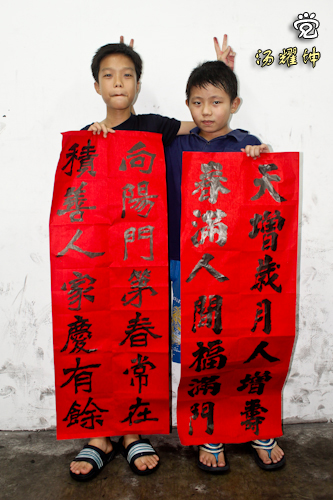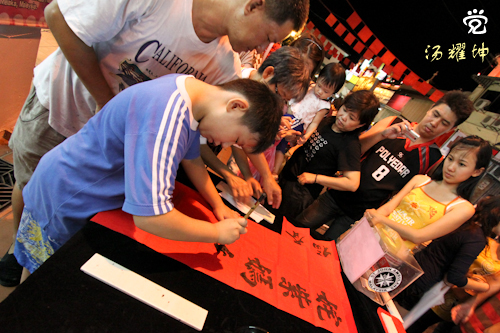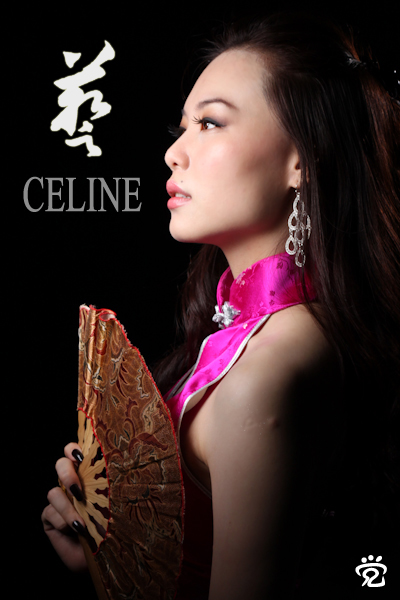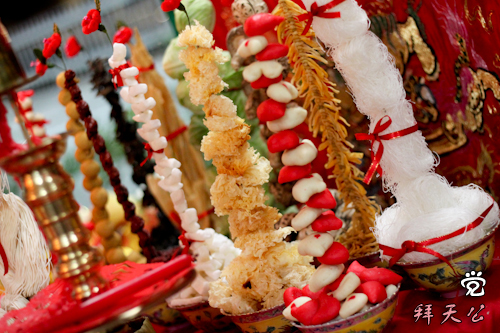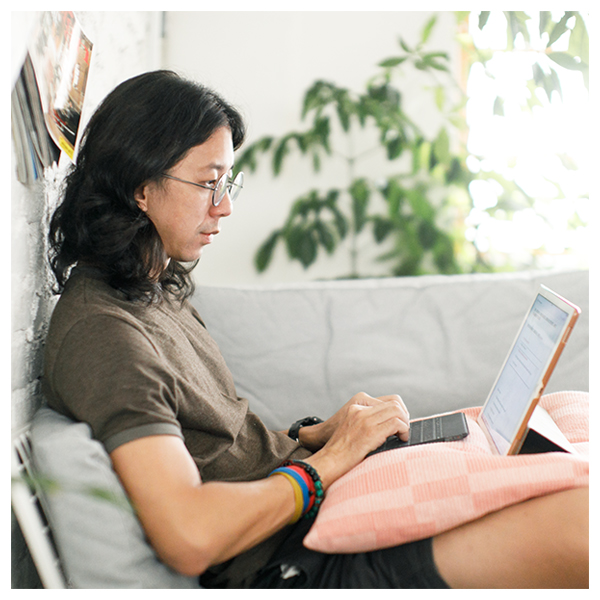元宵节也称灯节,元宵燃灯的风俗起自汉朝,到了唐代,赏灯活动更加兴盛,皇宫里、街道上处处挂灯,还要建立高大的灯轮。随着时间的推移,元宵节的活动越来越多,不少地方节庆时增加了耍龙灯、耍狮子、踩高跷、划旱船扭秧歌、打太平鼓等传统民俗表演。这个传承已有两千多年的传统节日,不仅盛行于海峡两岸,就是在海外华人的聚居区也年年欢庆不衰。
Read More
Today I dropped by Mahkota Parade, Melaka and saw this wonderful campaign supported by Mahkota Parade and Seck Kia Eenh temple to give financial aid to the cancer patients. There were hanging written wishes on the wooden frame by the kind public to make wishes, at the same time giving a loving hand to the less fortunate ones.
Ah Too and I tossed some coins into the big lotus as seen in the photo below and made some wishes. May everyone be happy. If you happen to be there, kindly donate what you can.
Mahkota Parade is proud to support the Melaka Seck Kia Eenh Temple Cancer Fund, which provides financial assistance to cancer patients, regardless of race.
Open your heart and lend a hand to this good cause and donate what you can. You may also light up a lotus candle and place your wishes for the news year for a minimum donation of RM10.
皇冠百利与马六甲释迦院联手为癌症基金出一份绵力,提供病黎财务上的援助。愿大家慷慨解囊与响应。每捐RM10或以上,您可为自己在新的一年祈福点灯。
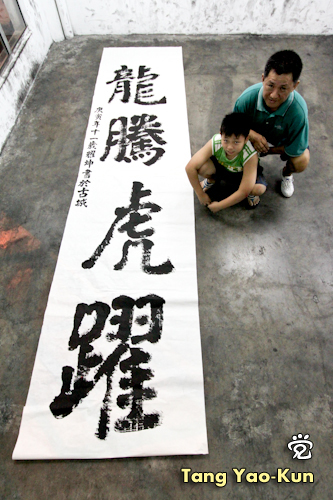
Little Tang (Tang Yao-Kun) with his Chinese calligraphy writing, "dragon leaps, tiger jumps". Behind is the teacher Mr. Liu Ming-Liang.
Many are amazed by the calligraphy writing of our little friend Tang (Tang Yao-Kun). One day during the calligraphy class, I chatted with Yao-Kun’s father.
3 years ago, when Yao-Kun was in kindergarten, he was a naughty and hyperactive kid. His teacher always suggested to his parents of bringing Yao-Kun to Mr. Liu Ming-Liang’s class to learn Chinese calligraphy. She added calligraphy is an art, a Chinese tradition, and also would be able to let little Tang settle down and more concentrate in his study. However, father Tang and mother Tang did not know much about calligraphy and thought that it would not be as useful to little Tang as told.
The kindergarten teacher insisted. Everytime father Tang and mother Tang went to the kindergarten, the teacher suggested the same thing again and again. Due to that, the parents reluctantly agreed and brought little Tang to Mr. Liu’s calligraphy class. They were however unsuccessfully locating the place of the class, and so they gave up.
The next time they met the teacher, again she suggested the parents to bring little Tang to the calligraphy class. Father Tang and mother tang felt sorry to give any excuse since the teacher really took this matter seriously and it would be for the own good of little Tang.
Where there is a will, there is a way: father Tang and mother Tang found Mr. Liu’s calligraphy class eventually and little Tang started his class since then. In addition, little Tang did not know about Chinese calligraphy at all. He took part in half-heartly. Mother Tang was in charge of bringing little Tang to class everyday.
Months after, and little Tang stepped into primary school year one. Father Tang was asking the performance of little Tang in the calligraphy class. He was told that little Tang was an excellent and well-behaved student in class. This appraisal of Mr. Liu however was a mistake because he was mistaken of little Tang’s name with another student. According to Mr. Liu, little Tang did not perform and not well-behaved in class. Even worse criticism was given by the teacher.
Father Liu was pissed when he was told and could not agree with Mr. Liu. He decided to take over the responsibility of little Tang’s learning from his mother, putting full supervision of little Tang’s learning and started to stay during the whole period of little Tang’s calligraphy class to check on him.
Not long after that, there was a competition. Father Tang encouraged his son to take part in order to gain experience and boost the interest of his son. This would be the first competition little Tang took part; also he was nervous as he had to write in front of a bunch of people and with other children. He finished the writing though.
During the prize giving ceremony for primary school students category, prizes were announced from the consolation prizes to 2nd runner up, 1st runner up then the best prize. Prizes announced respectively, the confidence of little Liu was getting lower and lower, and disappointment was getting greater. The prize giving ceremony for primary school competitors was over, and little Liu did not win any prize. He was so disappointed.
Little Tang insisted to stay for the later prize giving for junior high school category and high school category as he thought he might stand a chance in winning. Father Tang did not know how to explain to his son but he accompanied his son until the whole event was over. Both of the father and son were so upset. The son was let down because he didn’t win; the father was upset because the son.
During their ride back to home, both father and son didn’t speak a word. There was a moment of silence. Looking at the son, father Tang felt bad of forcing little Tang to the calligraphy class again. So he asked, “What do you want to do now?”
“Dad, I have to work harder!” he answered.
* * * * * * * * * * * *
3 to 4 years later after the first lesson of calligraphy, little Tang is 11 year-old this year. He is the star of Pay Fong 2 Primary school and many students and teachers are proud of little Tang. He has won many prizes in calligraphy competitions. The reasons behind the success are the patience of little Tang’s parents, the teaching of Mr. Liu, and also the hard work of little Tang.
Mr. Liu once told me, “Interest can be developed. Talent is nothing more important than hardwork, it only helps to acquire the skill quicker than others. The main keys of improvement are dedication and determination.” English physicist also said, “If I am anything, which I highly doubt, I have made myself so by hard work.”
Thanks so much to Mr. Liu for sharing his and his son’s learning experience with us. Hope that little Tang is able to continue with his hard work and be humble in his learning always.
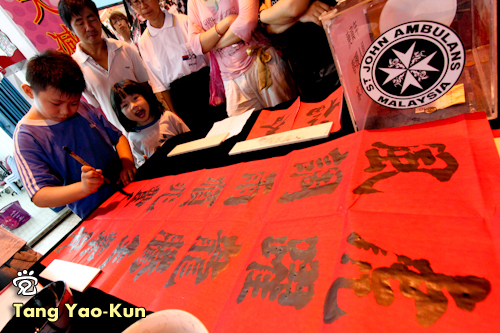
Little Tang was writing at the Jonker Street of Melaka for a charity event. Little Tang's cute sister and father were just standing beside him.
“Why did little Tang learn callligraphy? Because he was interested in?” I asked.
汤耀坤小朋友的书法是我们所见识到和羡慕的。我曾经问汤爸爸:“为什么他会学书法?是兴趣吗?”
当耀坤就读幼儿园时,他是一位好动和好玩的小朋友。幼儿园的老师常常推荐汤爸爸和汤妈妈,希望他们能带耀坤去刘明亮书法老师那里去学书法。这不只是一门艺术,也能让耀坤定定性。汤爸爸和汤妈妈商量后,觉得书法没有什么用,就没有带儿子去学。但是每一次汤爸爸和汤妈妈到了幼儿园,老师还是不断的提倡书法,希望耀坤能够去学习。
由于老师的热诚,汤爸爸和汤妈妈逼于无奈下带了耀坤去明亮老师的书法班。可是到了幼儿园的老师所指明的路行到了书法班的地区,却找不到书法班的所在。于是,他们又放弃了。
再一次,汤爸爸和汤妈妈见到了幼儿园的老师,她还是建议耀坤去学书法。既然老师都那么坚持,汤妈妈决定送儿子去学书法了。这次他们终于找到了明亮老师的书法班,耀坤也开始上课了。他那个时候根本不了解书法,只抱着玩玩的态度去学习,每次都由汤妈妈带去书法班。
耀坤学了不久,也是一年级了。汤爸爸有次问起明亮老师对儿子的评语,老师给了很好的评语。后来才知道老师搞错了学生,他还很不客气地批评了耀坤,说了耀坤不认真的学习态度。汤爸爸听了,真的吃不下这口气,认为老师太看不起自己的儿子。于是,他告诉汤妈妈,从今以后,他会亲自带儿子去学书法,也会留在书法班监督儿子学习。
在不久后,有了个书法比赛。汤爸爸当然支持耀坤去参赛,希望比赛能增广儿子对书法的认识,也促进他对书法的兴趣。第一次参赛的耀坤当然非常紧张,要当着那么多群众写字,和那么多人比赛。最终,他还是完成了他的字。当主办当局宣布小学组赛果的时候,耀坤也很紧张,而且也拭目以待,希望能拿个奖项。报告奖项是由比较低的安慰奖先报告,到优秀奖三、二、一名。一个个的报告了,也报告了第一名,许多的奖项,却没有耀坤的名。当然他很失望,很沮丧。
当报告初中和高中组的奖项时,耀坤还是抱着希望,叫爸爸不要带他离开比赛会场,可能他还会有希望得奖。汤爸爸知道儿子不肯放弃,也不知道怎么跟他解释,就一直陪着儿子到整个比赛结束了。儿子的希望最后还是破灭了。
在回家的漫漫的路途上,汤爸爸和耀坤在车上一直没有说话。爸爸瞧见儿子很沮丧,也很心疼,觉得不忍心逼着儿子再学书法了。于是汤爸爸是对耀坤说:“耀坤,你现在想怎么办?”
“爸,我要更努力!”耀坤回答。
* * * * * * * * * * * *
三、四年后的今天,耀坤今年十一岁了。他不只是培二小学师生校园之光,在之后很多的书法比赛都有不错的成绩,赢了不少的奖项。耀坤能有今天的成就,全是父母的鼓励、刘老师的教导和他自己的坚持和努力。
其实,很多兴趣是可以培养的,不一定要靠天分。刘老师和我说过:天分只能让某个人比别人更快的掌握技巧;而真正能进步的因素是靠努力。物理学家牛顿他曾这样说过:“虽然自已有某些方面的天分和才华,但仅靠天分的自然流露,没有自觉的勤奋努力是远远不够的。”
很谢谢汤爸爸和我们分享他和儿子的学习经历。愿耀坤小朋友能继续努力,虚心学习,方能更上一层楼。
有关汤耀坤的主题:
春暖人间、家家贴春联 - 到访文化小学、培二小学、平民小学和香林小学
春暖人间、家家贴春联 – 序幕
春暖人间,家家贴春联 – 春联义卖
A week before Chinese New Year, I went for a studio shooting together with Nick, James and other photonians to the Hananica Studio. It’s a photography studio located in Taman Kota Laksamana and well equipped with lighting equipment. Celine was the model invited and showed her expertise in modelling. She posed well and gave us so much cooperation with her happy smile all the time.
We would have to thank Nick and James, who were teaching us to setup the background and the lighting for the shooting. They are more experience in studio shooting than anyone of us; however they were willing to share their knowledge with us and telling us the importance of communication between the photographer and the model.
Post-processing would be another hard part to work out since most photos were taken in RAW format. Below are some of my shots after processing:
“传说明朝时一年的农历新年,倭寇在福建沿海一带,杀人放火,抢夺财物,乡民扶老携幼逃命。 乡民在黑夜中逃到一处偏僻郊野时,眼见倭寇就要追上,大家感到万分惊恐,突然前面出现一大片蔗林,乡民便逃入蔗林躲避,避过倭寇,逃过鬼门关。这天正是大年初九,逃出生天的乡民都认为这是天公救命,于是每年的大年初九凌晨便祭拜天公,以谢救命之恩。而拜甘蔗也具有不忘蔗林藏身救命之恩。”
“另一传说是,古时有一名孟将军,他到某个地方,只要喝了当地的水,就会讲当地的话,他就以这门本事辨别汉人。 可是他到了福建,手下竟然拿了外省的水给他喝,结果他一直不懂讲福建话。他便以为福建人不是汉人,就下令大开杀戒,福建人枉死无数。到了大年初九那天,从外省运来的水喝光了,孟将军才喝到福建的水,会讲起福建话,这时他才知道杀错人,马上下令封刀。而福建人认为这是天公所赐,让他们逃过大劫,便在初九凌晨拜天公谢恩。”
前两天是农历正月初八,也福建人的新年。我、Wee-Peng和Jason到访了Jason的两个伯母的家和Murphy的家去见识福建人的拜天公。同时我们也见识到了峇峇福建人为拜天公准备功夫的细腻。
Two days ago (Sunday midnight) was the 8th day of the first month of lunar calendar. On the 9th day, it would be the celebration known to the Hokkiens as ‘Bai Tian Gong’, which literally means ‘praying the Heaven God’.
During a Chinese New year of the Ming Dynasty, there was a bandit raid in the province of Hokkien. These intruders however robbed and burned down villages, attacked and killed the villagers. The people of the villages were in fear and escaped from their burnt villages during the night.
Some of the villagers then hid themselves among the sugarcane fields. Needless to say, those villagers prayed to Heaven God (Tian Gong) for salvation during their hideout. The pursuing intruders spent many days trying to locate and hunt them but to no avail. On the ninth day of that Chinese New Year, they finally gave up and returned to their region.
The Hokkiens then happily emerged from the sugar cane fields, and praising the blessings of the celestial deities and owing gratitude to the sugarcane plants for saving them from destruction. Thus, in all Hokkien celebrations, the sugarcane plant is given prominence.
Realizing that it was also the 9th Day of the Chinese New Year and coincidentally the birthday of Heaven God, they decided to make votive offerings and prayers to the Jade Emperor for their salvation. There are many version of the Hokkiens’ Bai Tian Gong stories. Whichever it is, the hokkiens believe that our life and prosperity are granted by the Heaven God.
On the eve of the 9th day, a pair of sugarcane plants are used by the Hokkiens usually placed one on each side of the offering table or the front door of the house. The pair of the sugarcane symbolises unity, cooperation and strength. The sugarcane itself is a symbol of harmony and a token which can bring good and ‘sweet’ results. The very straightness of the sugarcane stem also ensures that the Hokkiens can become a clan of honest and sincere people.
Three family houses I visited together with Jason and Wee-Peng, two of my best friends on the eve of Bai Tian Gong festival. The first two houses we visited were the family of Jason’s aunties, and the last house we went was my best friend, Murphy’s house. Jason comes from a Baba-and-Nyonya family so the prayers of Tian Gong for them is a grant event of the year. The celebration they held for the past few years I visisted were so unique and special. Each of the table setup and the offerings, the preparation were carefully done and also involved a lot of manpower.
Share the photos I have taken:
